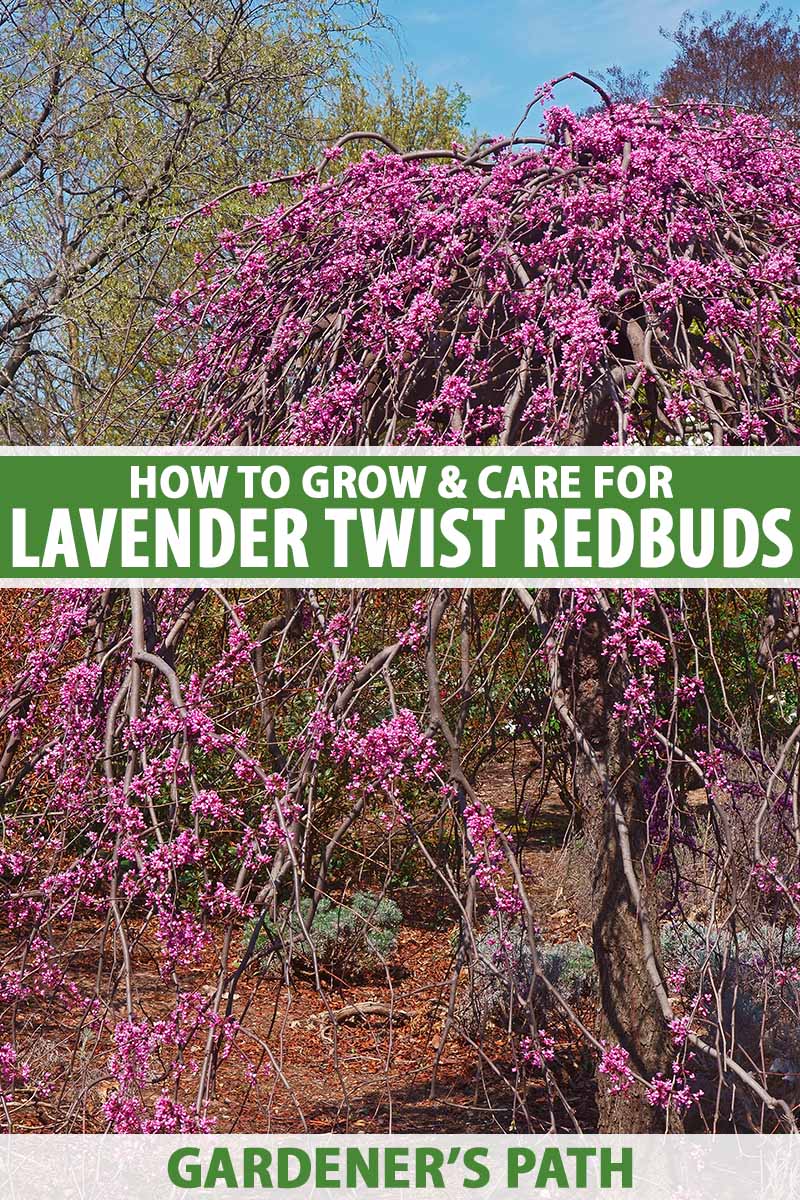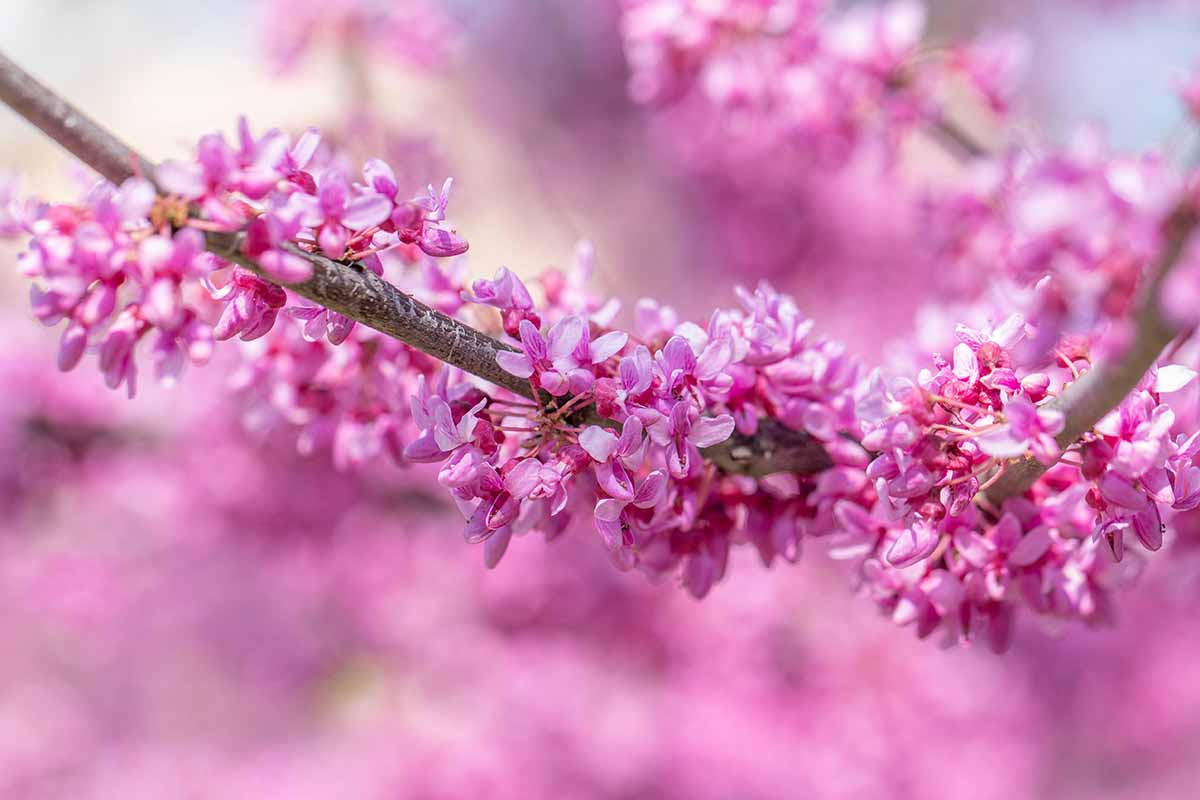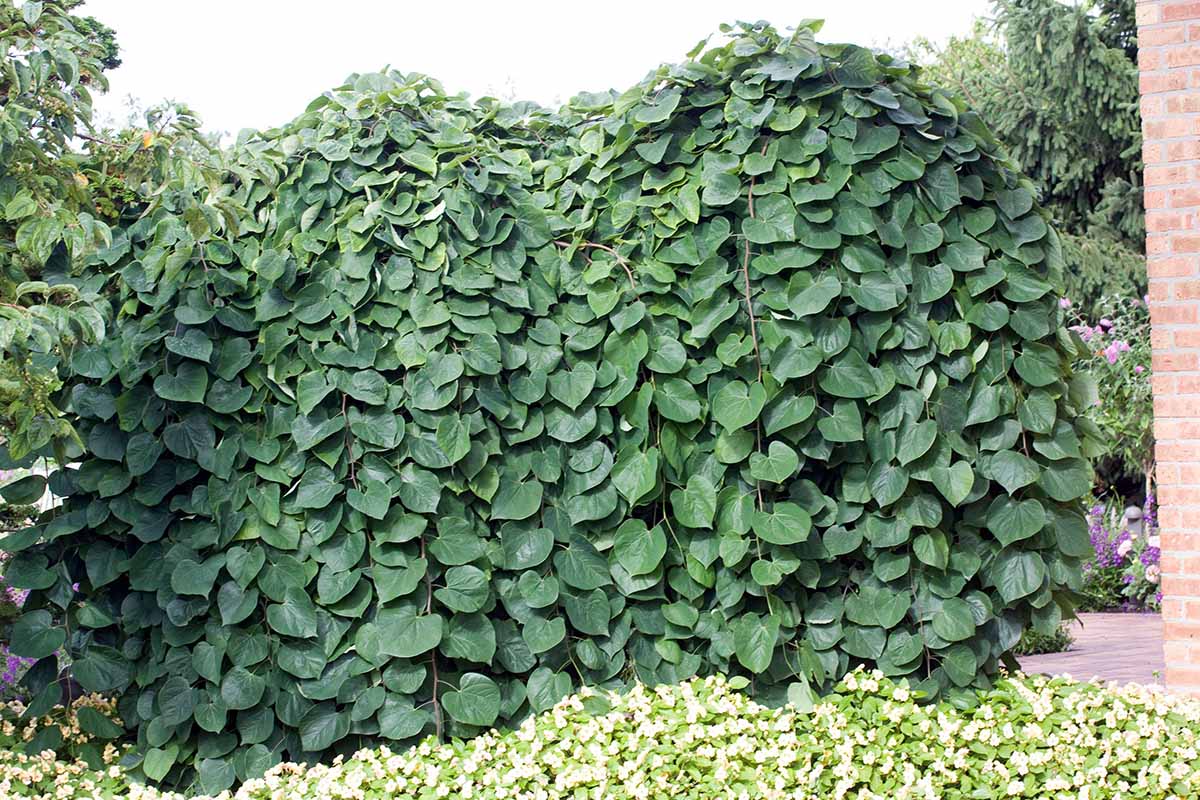Cercis canadensis ‘Covey’
I like to think of myself as someone who loves all redbuds equally. There’s something magical to find in each and every one.
But, of course, were I forced to pick a few favorites lest I be banned from ever owning one again (heaven forbid), there are a few that I could play favorites for.

We link to vendors to help you find relevant products. If you buy from one of our links, we may earn a commission.
Lavender Twist® is at the top of that list. An eastern redbud (Cercis canadensis) cultivar with all the best that these trees have to offer, it’s pretty impossible not to fall in love.
If you’re looking for a weeping redbud that stands out from the very, very large crowd, it’s worth considering Lavender Twist®. It’s intensely floriferous with vibrant fall foliage, all in a compact package.
We’re going to talk all things ‘Covey’ in this guide, touching on its history and explaining how to make it happiest. Here’s a quick preview of everything we’ll discuss:
What You’ll Learn
If you’re new to growing redbuds or just want some extra general knowledge, please visit our guide to growing redbuds.
It goes over all the basics of the Cercis genus and how to cultivate these plants.
When you feel like you’re ready to do the twist, come back here, and let’s jump in.
Cultivation and History
Lovely Lavender Twist®, sometimes called ‘Covey,’ is a dwarf, weeping redbud cultivar that lends itself perfectly to small gardens or even containers.
Tim Brotzman of Brotzman’s Nursery in Madison, Ohio, bred the stunner after he was sent some scions of an unusual weeping redbud.
It took him 50 tries to get it right, but once he did, he was rewarded with a twisting, weeping tree so distinct that gardeners ask for it by name.
The cultivar name is actually an homage to Cornelia Covey, the woman who owned the original tree that was growing on her property in Westfield, New York.
Several years after the tree found success in cultivation, Cornelia’s neighbor recounted how the original plant was almost unceremoniously cut down while he was helping her remove unruly lilacs from the yard.
Since he wasn’t sure what kind of plant it was, he said that he decided to let it be for the time being. It was later sent to Brotzman and the rest, as they say, is history.
Talk about a happy accident!

So what makes Lavender Twist® so awesome? Well, the first thing most people look at with redbuds is the blossoms. With this tree, the branches are completely covered in vibrant, rosy lavender blooms.
Next, with a weeping tree, we all want to know what height and width it will eventually reach. ‘Covey’ is a true dwarf, reaching about six feet tall and eight feet wide.
After the blossoms fade in the spring, the attractive leaves are medium green and glossy, with a distinct heart shape. In fall, the foliage turns copper, yellow, and gold.
So that’s three seasons covered. But Lavender Twist® continues to impress in the winter with its zig-zagging branches, which look all the more interesting covered in a layer of snow.
Ready to plant one? Do you live in USDA Hardiness Zones 5 to 9? Then let’s go!
Propagation
The only way to propagate ‘Covey’ is to buy a plant from a nursery.
That’s because it’s patented, and any other type of propagation is prohibited. And that means you shouldn’t be begging cuttings off of your neighbor.
Fortunately, it’s a popular cultivar, so it shouldn’t be too hard to find one. We’ll provide suggestions in the section below on where to buy plants, so keep reading!
Once you bring a live plant or bare root specimen home, assuming it’s spring or fall, prep the planting area. Dig a hole twice as wide and twice as deep as the container or root ball. Mix the soil that you dug out with well-rotted compost and fill the hole back in halfway.
Set the plant in the hole so the crown or root flare is above the soil line. The trunk can’t be buried at all. Fill in around the roots and tamp it down. Water the earth well and fill in with a bit more soil if it settles when you water.
How to Grow
Lavender Twist® does best in full sun, but if you live somewhere with sweltering summers, give it a bit of afternoon shade. The soil pH needs to be around 6.5 to 8.0, and the earth should drain well.

This cultivar isn’t as drought tolerant as some others, but it’s quite drought tolerant nonetheless. Offer up some water when the top three inches or so of soil dries out.
Feed your tree once a month during the growing season with an all-purpose, balanced fertilizer. Something like Triple 10 All Purpose Liquid, with a 10-10-10 NPK, is just right.

Pendleton Triple 10 Fertilizer
For 32-ounce bottles, head to Amazon.
Also, remember that all C. canadensis trees need around 500 hours below 45°F per year to truly bloom well.
Container Growing
Because of its petite size, Lavender Twist® is an ideal candidate for container growing.
Choose a pot at least two sizes larger than the pot that it’s currently growing in when you bring one home from the nursery.
Try to err on the side of too large rather than too small, because the extra dirt will provide insulation during the winter.
Pick whatever type of pot will work best for you. Terra cotta tends to crack in the winter, metal gets hot during the summer and cold during the winter.
Fiberglass, wood, concrete, or insulated plastic pots generally work best.
Don’t place a layer of rocks in the bottom. Fill it right up with potting soil and plant at the same depth that it was growing originally in the nursery pot.
Caring for container-grown redbuds is generally the same as what you would do if one was planted in the ground.
But you’ll want to wrap the container in burlap or some other form of insulation in the winter if you have an extended and unusual cold snap or cycles of freezing and thawing.
A thick layer of mulch placed on top of the soil will help as well.
Growing Tips
- Plant in full sun.
- Water when the top three inches of soil dry out.
- Fertilize once a month during the growing season.
Pruning and Maintenance
Left to its own devices, as with most weeping trees, Lavender Twist® won’t have that perfect umbrella-like shape.
It will slump over like an old lady in a cartoon with an exaggerated “Dowager’s hump,” branches trailing along the ground.

If you don’t mind that look, then you don’t need to do much, if any, pruning until the tree is a bit older. If you buy a slightly older plant to start, the grower will have already done this training for you.
Everyone else will need to give the youngsters some lessons in appropriate posture when they’re one to two years old, three years max.
To do this, once the ground can be worked in early spring, take a good look at the shape. Find the most robust, healthy branch at the very top of the tree and cut everything else off. Give these superfluous branches the chop as close to the trunk as you can.
Now, sink a stake in the pot or ground right next to the trunk of the plant. Take that remaining branch and pull it straight up. It might have some funky twists in it, but that will just add to the character.
Fasten the branch to the stake using tape or twine.
Now, just let it grow. In a while, it will start sending out new growth from the top, and you’ll have that tall, arching, umbrella-like shape that’s so attractive in weeping plants.
If you purchased a tree that has already been trained or you trained your own, and now it’s more mature, the only pruning you need to do is to remove any dead, diseased, or broken branches and to thin out the canopy a little when it becomes crowded.
You can also chop off the ends of the branches if they’re growing too low to the ground for your taste.
Redbuds are cauliflorous, which means they bud on main stems and older growth rather than on new growth as many plants do. For that reason, it’s pretty hard to mess up the pruning and ruin the coming year’s floral show.
Where to Buy
Ready to bring one home? Local nurseries are a great place to start.
Fast Growing Trees also has live plants available in three- to four-, four- to five-, and five- to six-foot-tall heights.
And the Lavender Twist® trees at Planting Tree come in three- to four-, four- to five-, and five- to six-foot-tall options that have been trained to have that elegant form most people are looking for.
Managing Pests and Disease
Lavender Twist® isn’t uniquely resistant to any of the pests and diseases that can impact redbuds.
Watch for leaf rollers (Fascista cercerisella) and emerald ash borers (Agrilus planipennis), as well as canker (caused by Botryosphaeria spp.) and verticillium wilt (caused by Verticillium albo-atrum). Learn more in our guide.
Best Uses
Lavender Twist® makes an excellent specimen as a centerpiece for a small garden or in a container for added interest on a patio, deck, or flanking an entryway.
The flowers are also edible and create a real wow moment whenever you use them in recipes.
Quick Reference Growing Guide
| Plant Type: | Deciduous, cauliflorous tree | Flower/Foliage Color: | Rosy lavender/green, copper, yellow, gold |
| Native to: | North America | Tolerance | Drought |
| Hardiness (USDA Zones): | 5-9 | Maintenance: | Low |
| Bloom Time: | Spring blooms/fall foliage | Soil Type: | Sandy, loamy |
| Exposure: | Part shade to full sun | Soil pH: | 6.5-8.0 |
| Time to Maturity: | 7 years | Soil Drainage: | Well-draining |
| Spacing: | 4 feet | Attracts: | Bees, butterflies, hummingbirds |
| Planting Depth: | Same depth as container (transplants), roots just below the soil line (bare root) | Companion Planting: | Bluebells, phlox, violets, wood lilies |
| Height: | 6 feet | Uses: | Container, edible, specimen |
| Spread: | 8 feet | Family: | Fabaceae |
| Growth Rate: | Fast | Genus: | Cercis |
| Water Needs: | Moderate to low | Species: | Canadensis |
| Common Pests and Diseases: | Emerald ash borers, deer, leaf rollers, rabbits; canker, verticillium wilt | Cultivar: | Covey |
Come On, Do the Twist
Redbuds are pretty eye-catching trees to begin with. Then you add more blossoms per inch on a compact, weeping tree, and you have something truly exceptional.

How do you plan to use your Lavender Twist®? Will you put it in a container to liven up a patio? Let it act as a centerpiece in a small garden? Share your plans with us in the comments.
I hope that guide helped you to feel confident in raising this plant. If you would like to learn more about redbuds, check out these guides next:

What a brilliant article this is, Kristine. Cheers, Nerida
Thank you for the kind words!
We planted a Lavender Twist May 2022; it was in full bloom. This year, it bloomed a little and now, May 15 it seems like it is done. why?
Sometimes growers force a plant into bloom so that it looks more impressive on the market. After being in the ground for a year, it will return to its normal blooming routine. Depending on where you live, it’s completely normal for a redbud to be done blooming by May 15. When I lived in Utah, redbuds were done by the end of April. What region are you located in?
We had a beautiful 4 or 5 year old lavender twist that broke off in a windstorm. I pulled the damaged trunk out and discarded it. Now, like 3 years later, 4 closely packed shoots of the original have popped up. And they look very healthy.
Can I twist them together and make a more upright tree or should I follow your recipe (pick the best shoot and cut the rest back)?
Hi Jay, while I wouldn’t twist the stems, you could certainly let the four shoots grow and just train your tree in a more shrub-like vase-shaped form. If you want an upright, traditional single-stem tree, then definitely pick the strongest stem and remove the others.